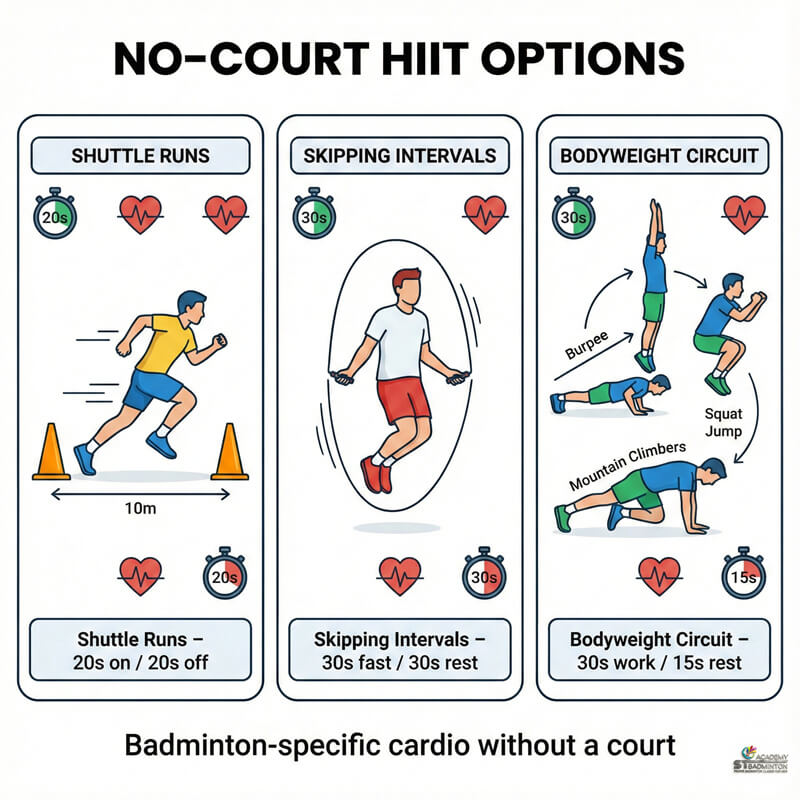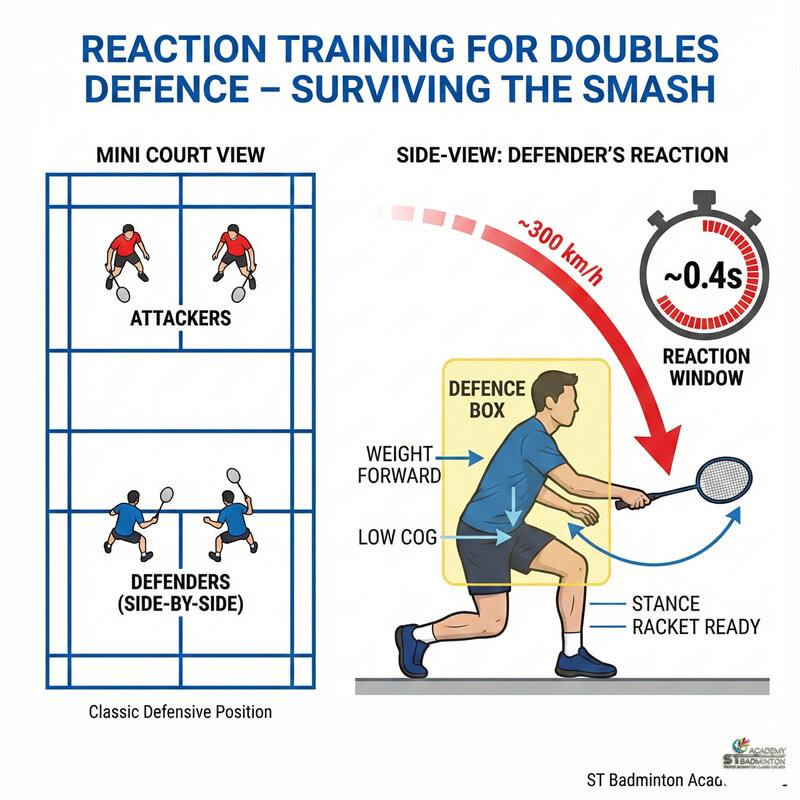Learning Badminton: Mastering All the Basic Rules
Definition and purpose of training
This article provides an overview of the basic rules and techniques needed to become a professional badminton player. ST Badminton Academy will explain the essential equipment like a racket, court layout, and services needed to play the game. It also includes a breakdown of the scoring system and how to score points. And also the covers basic strategies and techniques to help players improve their play, such as proper footwork and shot selection. Finally, tips on how to practice and further improve the game are discussed.
Beginner Guide
Do you have a racket? Or have you put inside the store room for a long time. Bring it out now, as now Singapore and Malaysia badminton is become more popular ever than before. Don’t know what is badminton exactly? Quick explanation, badminton is a racquet sport played between two or four players or more than that if you are in badminton training.
It is played with racquets and a shuttlecock, a small, round, feathered object from various brands. The objective of the game is to hit the shuttlecock over the net onto the opposing player’s court. Points are scored when one player fails to return the shuttlecock to the other side of the net. Badminton is need a lot of footwork, agility, strength, consistency, and accuracy in short.
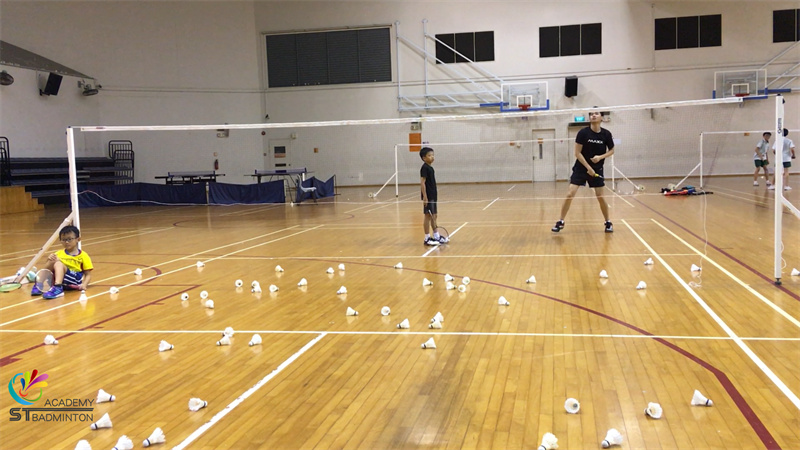
1. The Badminton Court
A badminton court we have normally seen in the Sports hall and CC can be a multipurpose hall, and the court line can messy sometimes, but the good thing is can save place. The court is a rectangular area divided into two equal halves by a net that stands 1.55m (5ft 1in) high at the posts and 1.524m (5ft) in the center. The court measures 13.4 meters (44ft) long and 6.1 metres (20ft) wide. The court is typically marked with lines that help players determine out of bounds and in-bounds areas.
The badminton court is also divided into different zones. The zones are the left and right service courts, the forecourt and the rear court. The service courts are marked by a short service line, a long service line and sidelines. The forecourt is the area in front of the short service line and the rear court is the area behind the short service line.
At each end of the court, there are two posts that are used to support the net. The posts are 1.55 metres (5ft 1in) high and are set 1.35 metres (4ft 5in) outside the sidelines.
The badminton court also features two tramlines, which are imaginary lines running parallel along the court and extending 1.98 metres (6ft 6in) beyond the sidelines. These lines are used to determine whether a shot is playable or not.
Finally, the court also includes a back line, which is the line at the back of the court furthest from the net. This line is used to decide the boundaries of a badminton shot and it needs to be crossed for a shot to be considered legal.
Badminton courts are typically located indoors, but can also be found outdoors. They can be made from a variety of materials including wood, tile, or synthetic surfaces and we will call them rubber courts.
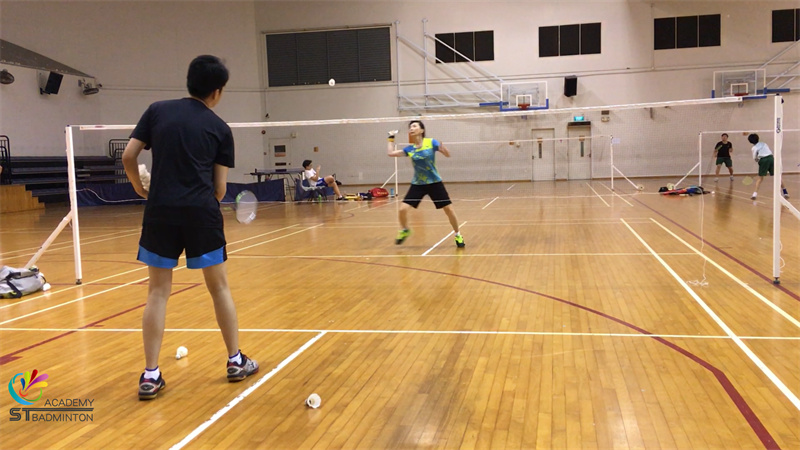
2. Rules of Badminton
There are specific rules and regulations in badminton that you must abide by in order to play it correctly. Here, we’ll take a look at some of the basic rules of badminton.
Serving
Players must serve diagonally across the court, with the serve passing over the net, and must also land within the boundaries of the service court on the opposite side. For example in double, if not pass the boundaries, we call it short, if, over the back line of the box, we will call it out.
Scoring
A player will score a point when the opponent fails to return the shuttlecock or when the shuttlecock hits the ground. The first player to score 21 points wins the game unless the score is 20-20, in which case the player must win by 2 points.
Faults
Faults include any action that prevents the shuttlecock from being returned over the net, such as hitting the shuttlecock before it passes the net or double hitting the shuttlecock. In international competition, If a player exceeds 1.15 metres will consider fault too. But for the casual game, not much related as long as not too much.
Foot Faults
Players must also be aware of foot faults, which you must stand position and cannot move until you serve your shuttlecock over. Another means is you must hit the shuttle over before you can move your leg.
Doubles Play
When playing doubles, players who serve must always remain in their designated area. And there are many rules that are different between single and double.
The Lines
The shuttlecock must always land within the boundaries of the court and cannot over the lines.
Out of Play
Players should also be aware of when the shuttlecock is out of play. If the shuttlecock hits the ground outside of the court boundaries or hits the ceiling or any other object, the point is over and the opponent will score, which means you lose the point.
These are just a few of the basic rules of badminton that all players should be aware of.

3. Types of Shots
There is a wide variety of shots that can be used to win a game. Whether it’s a competitive game or just a friendly match, the right shots can make all the difference. Here are some of the most common shots used in badminton and how to get the most out of them.
Clear Shot
This is a shot played from the back to back of the court that is used to drag opponent’s stamina. The clear shot should be high and deep so that your opponent has to move back to reach it. You can also use the clear shot to set up a more aggressive shot like a shooting lob, which provides fast speed.
Drop Shot
This is a shot played close to the net that is used to surprise your opponent. By taking a few extra steps to the backcourt and waiting until your opponent is back in the middle to wait for the shuttlecock. You can drop or cross drop the shuttlecock at their front net to make them difficult to run and gain an easy point especially if they are beginners.
Smash Shot
This is a common shot that is hit with a lot of force, and smash sharper if you are single. It is used to put your opponent under pressure and win the point if they are not good at defense. Smashes are usually played from the middle half-court and the back of the court depending on the opponent’s return, but they can also be used from the front, but we call it a tab shot, depending on the situation.
Drive Shot
The drive shot normally can be seen in our badminton training. This is a useful shot that is used to send the shuttlecock straight and fast over the net and toward your opponent’s body. It is usually played from the middle and front of the court with forehand and backhand wrist push. This is used to put your opponent on the defensive and lift up the shuttlecock for you to smash.
Backhand Shot
The backhand shot is played from the backhand side and is used to surprise your opponent. It is a great shot to use when your opponent is expecting a forehand shot. But it can be weak if you have not learned the proper way of a backhand shot in badminton training.
Net Shot
The net shot is a shot played close to the net that is used to disrupt your opponent’s rhythm. Force them to lift up the shuttle for your partner to attack if you are playing double. And can crash your opponent if the netting quality is good. It is usually used when your opponent is returning to the middle of the court expecting a higher shot, such as a clear or a smash.
Lob Shot
The lob shot is a shot played high over the net and is used to control the pace of the game. It is usually used to get your opponent off balance and gain an easy point. Especially for some older age players who do have not much stamina.
These are just some of the many shots used in badminton. There are many more like, spin net, spin serve, forehand, backhand smash, cross, and more. But is important to practice each type of shot so that you can improve every one of them and become a so-called “good” badminton player when people can remember your name in badminton.
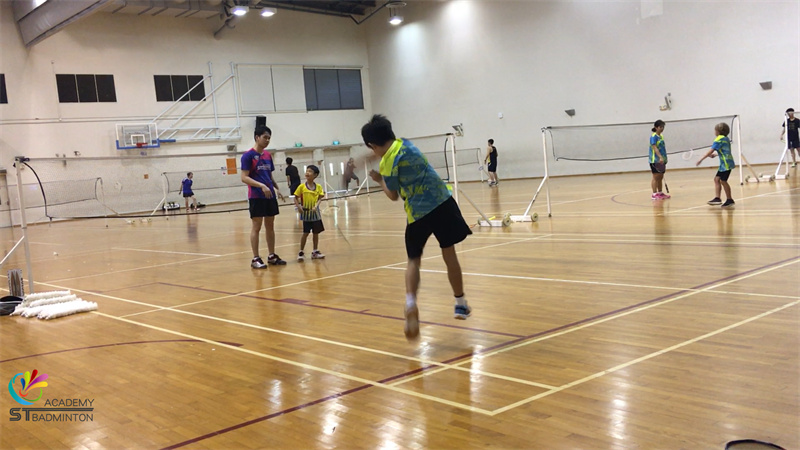
4. Equipment Used in Badminton
Badminton rackets
Nowadays rackets come in a variety of materials, patterns, and weights and are usually made of light and durable materials such as graphite, boron, and titanium (Very old). The strings used also vary in tension and thickness, which affects the performance of the racket.
Shuttlecock
Shuttlecock also known as a birdie, is a projectile that is hit back and forth during a game of badminton. It is made with goose feathers if the quality is good like RSL and Yonex brands. The shuttlecock has to be carefully selected to ensure that the weight and flight characteristics are suitable for your levels of play.
Shoes are also an important piece of equipment. They are specially designed to provide traction and support in order to prevent slipping and injury. For our badminton coach, he prefers Mizuno and Li-Ning shoes. Shoes should be chosen rubber type, flat bottom for indoor to fit the player’s feet comfortably, as well as provide proper support to the ankles and feet.
Net
Net is another important piece of equipment used in badminton if you are playing outdoors. For indoor normally will have the net installed by the CC or Sports hall. The net is usually made from a durable material such as nylon or cotton, the hole density smaller is better. The height of the net should be measured to ensure that it is the correct height for the game which is 20′ (6.1 m).
5. Strategies for Learning Badminton
If you’re looking to improve your game, here are some strategies for learning badminton that can help you to improve better.
1. Practice regularly
The key to improving your badminton skills is to practice regularly in the right way. Try to make it a part of your routine, or join a badminton academy to learn with a badminton coach. Set aside time to practice each week after your training, and stick to it. Make sure you focus on the skills you need to work on.
2. Work on your footwork
As a good player, footwork is important as you need to be able to move and react quickly to shots, and your footwork will determine how successful you are. Work on your footwork by doing drills and practice games. Or doing some agility exercises at home will be the best to remain the speed. Work on improving your balance and agility in short.
3. Improve your serve
Your service is the most important shot in badminton, many players in Malaysia and Singapore can do a lot of mistakes on service in 1 game with 21 points, according to our badminton coach. It’s important to practice your serve then so you can be consistent with it. Work on your technique, including your grip, toss, and contact point, if you can use it, can learn more advanced serve as spin serve. You should also vary your services as well, so your opponent can’t guess what’s coming and push on you.
4. Develop your strategy
A great way to improve your game is to have a good strategy, which means you know where you want the shuttle to go to make it your opponent hard to return. Think about how you can outplay your opponent by anticipating their shots and placing your shots correctly. You should also have a game plan and stick to it. Not just return the shuttle to an opponent and let them play you around.
5. Have the right mindset
If you have the right mindset, do not be nervous if you met some good foundation player. Learn from them if you really want to improve your skill and confidence level. The mindset must be consistent, stop doing that like when saw a good skillful player and feel scared even though the game is not yet started playing.
6. Finding a Coach or Training with ST Badminton Academy
Finding the right badminton coach or badminton classes for kids can be a difficult task in Malaysia. You want to make sure you’re getting the best badminton training possible so you can reach your maximum potential as a badminton player instead just wasting time. That’s why it’s important to do your research and find a proper badminton academy with experienced coaches and training.
At ST Badminton Academy, we offer badminton lessons and private badminton training for both beginners, and intermediate to advance badminton players, especially for kids. Our badminton coaches have a huge of knowledge and experience and are dedicated to helping our students to improve within a short period of time. Whether your children are just starting out or looking to take your game to the next level, we have the perfect training for you.
Our badminton lessons are customized for the individual needs of each student. We offer both group and private lessons so that you can find the right coach and training to meet your individual needs and goals.
For our badminton academy, holiday camps are well known only for existing students. The purpose of this training is designed to provide an immersive learning experience that allows our students to quickly learn, polish and perfect their skills.
7. Practicing Drills and Exercises to Master the Basics
Drills and exercises are an effective way to practice and improve your skills in badminton. Not only do they help you get better, but they also help you develop good habits and improve your form in just 2 hours of games.
So, what drills and exercises should you do to master the basics? First and foremost, the most important drill is the footwork drill. You can do this on your own anytime when you have time without joining a badminton academy. It’s the foundation of all badminton skills and will help you develop the skills needed to play the game. The drill consists of shuffling left and right, moving forward and backward, and jumping. Once you have the basics down, you can start to add more complex footwork drills such as the “T-Step”, “Jump Step”, and “Turn Step” or look for a badminton coach to guide you.
Another important drill to practice is the “smash”. This is the most useful skill in badminton and requires quick reflexes and good timing, and a good wrist too. Focus on hitting the shuttlecock with keep finding the right of your power and accuracy.
The next drill to practice is the “drive”. This is the most commonly used stroke in badminton and is perfect for attacking your opponent’s body. To practice the drive, train with your partner drive and push at a fast speed for 10 minutes, more rallies will be good, do it until you can feel your hand and wrist are tiring, which means you are on the right way. Focus on hitting the shuttlecock with a flat just a nice passing through the net is good.
The last drill to practice is the “clear”. This is a defensive stroke and is used to give yourself time to set up for a return shot. To practice the clear, train with your partner do clear shot training for 5 to 10 minutes.
8. Utilizing Different Types of Shots to Your Advantage
As a badminton player, you will have one skill shot that you feel confident and comfortable executing in-game. Find the advantage your own from your skills, and use it in-game. A lot of players in Malaysia and Singapore, when have not learned any foundation before. They might hard to find their advantage shot, this is why we always teach our students with the right foundation to ensure they can stand out from others.
Staying Motivated During Learning Badminton
Playing badminton, especially for kids, can be more mature when they reach a higher level. It also can be a lot of fun, we understand it can also be a challenge to stay motivated when you’re just starting out. Whether you’re trying to improve your skills or just want to stay active and have some fun, it’s important to stay motivated during your badminton learning. Here are some tips to help you stay motivated while learning badminton.
1. Set realistic goals
The first step to staying motivated during practice badminton is to set realistic goals. When you know what you want, and when you achieve it, you will feel energetic. Setting goals that are achievable will help keep you motivated and on track. When setting goals, focus on small, achievable goals rather than large, long-term goals. This will help keep you from getting discouraged when you don’t reach your larger goals in learning badminton.
2. Get creative
When you are learning badminton, it’s important to mix things up and get creative. Try different drills and games to keep your learning sessions fun and challenging. For example, you can do a series of drills exercise like Monday, skipping rope, Tuesday for footwork, Wednesday rest, and Thursday for the game, etc. This will help you stay motivated and push yourself to your limits.
3. Track your progress
Tracking your progress will help you stay motivated during practice badminton. Write down the drills you do, how many shots you hit, and any other notes. Doing this will help you identify your strengths and weaknesses and set new goals to work towards.
4. Celebrate your successes
Whenever you reach a goal or make progress toward a goal, celebrate! For example, eat the food you like. This will help keep you motivated and remind you of the progress you have made. Celebrating your successes can be as simple as taking a break and rewarding yourself with a smoothie or a new badminton shirt or racket.
5. Take breaks
When you’re learning badminton, it’s important to take breaks to rest and recharge. Taking a break will help you stay motivated and will also prevent burnout. Taking a break doesn’t have to mean taking a day off; in sport science, we often use it for chronic adaptation.
Playing with Others to Improve Your Skills
Playing badminton with others is a great way to improve your skills and have a lot of fun. Whether you’re a beginner or an experienced player, playing with others will help you get better and take your game to the next level.
You’ll learn how to read your opponent’s shots and how to anticipate their next move. This will help you become a better player in the long run. The better player you meet, the better improvement you have.
Playing with others also helps you learn strategy and tactics. You’ll learn how to pick the right shots, where to place them, and when to go for the more aggressive moves. If you’re playing with someone more experienced, they can help you understand the game better and give you tips on how to improve. Just like some uncles when losing the game, they will come to you and nag you, in other means, they are teaching you actually.
Playing badminton with others is also great for motivation. When you’re playing with someone else, you’ll have someone to help push you and keep you motivated. This is especially important if you’re playing with a more experienced player. Playing with others can help keep you focused and help you stay motivated.
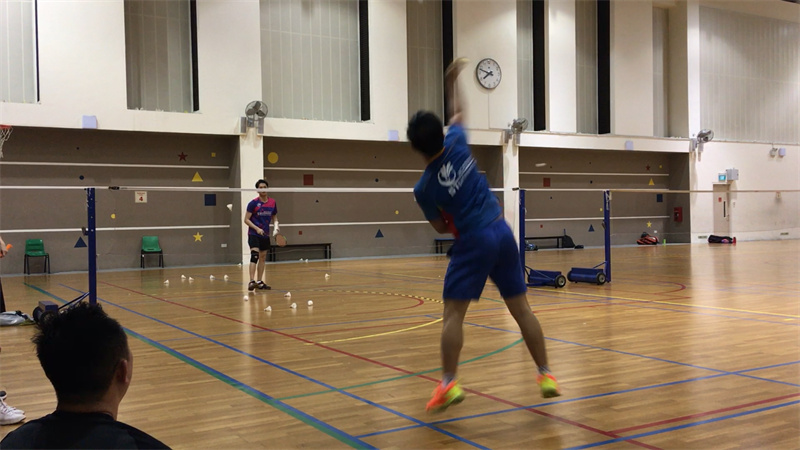
Back to the training home page.

